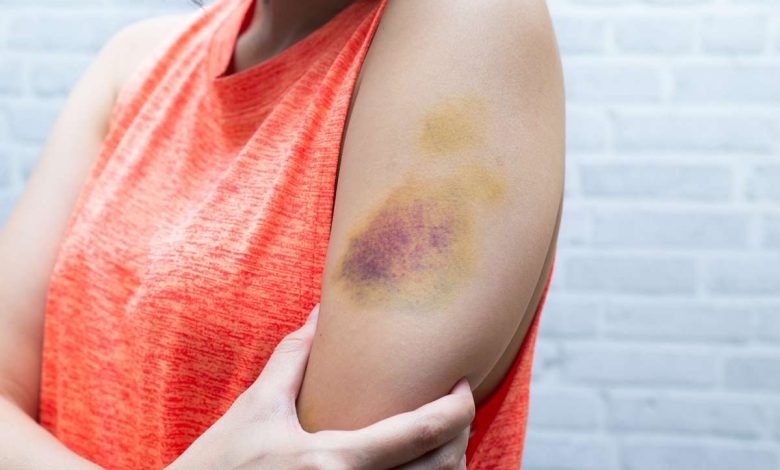Hemorrhage in the skin, purpura: what is this, causes, symptoms, diagnostics, treatment, prevention

Bleeding into the skin; bruises; Skin spots – red; Pinpoint red spots on the skin; Petechiae; Purpura
What is a hemorrhage in the skin?
Hemorrhage into the skin, known as purpura or hemorrhagic purpura, represents a state, in which the blood vessels in the skin are damaged, which leads to leakage of blood into the surrounding tissues. The result is a bruise, bleached, which may vary in size and shape.
Bleeding into the skin is usually caused by a disease, such as a bleeding disorder, but can also be caused by trauma, certain medications or autoimmune diseases.
Causes of hemorrhage in the skin
The most common cause of bleeding into the skin is a disease, such as a bleeding disorder. This can occur, when the body cannot produce enough protein, necessary for the formation of blood clots, or when the body makes too many of these proteins, and they become overactive. Bleeding into the skin can also occur as a result of trauma., certain medications or autoimmune diseases.
In some cases, bleeding into the skin can be caused by a vascular disorder.. It's a rare condition, that damages the walls of blood vessels, making them weak and prone to breaking.
Purpura can be caused by a number of factors., including:
- Trauma: Trauma to the skin can lead to rupture of blood vessels and bleeding into surrounding tissues.
- Blood clotting: Such diseases, like von Willebrand disease, idiopathic thrombocytopenic purpura and hemophilia, may cause purpura.
- Medicines: Some medications, eg, blood thinners, can cause easier bleeding in the blood vessels.
- Infection: Certain infections, eg, strep infection, may cause purpura.
- Vasculitis: Inflammation of the blood vessels can cause them to rupture and bleed into the skin.
When to Call a Healthcare Professional for a Bleeding in the Skin
If you notice any signs or symptoms of bleeding on your skin, it is important to seek immediate medical attention. Your doctor can determine the cause of bleeding and prescribe appropriate treatment..
Symptoms of hemorrhage in the skin
The most common symptom of bleeding into the skin is discoloration, bruise-like, which may vary in size and shape. The color change is usually purple or red and may be painful to the touch.. Other symptoms may include swelling, pain and itching.
Diagnosis of hemorrhage in the skin
If you suspect, that you may be bleeding into the skin, it is important to seek immediate medical attention. Your doctor will perform a physical exam and may order these tests, like complete blood count and clotting tests, to check for any underlying diseases. Your doctor may also order imaging tests, such as ultrasound or computed tomography, to get a better view of the affected area.
Treatment of hemorrhage in the skin
Treatment for bleeding into the skin will depend on the underlying cause.. If bleeding is caused by any disease, the doctor may prescribe medication to correct the condition. If bleeding is caused by trauma or vascular disease, the doctor may recommend surgery to repair damaged blood vessels.
Home treatment for hemorrhage in the skin
If bleeding into the skin is weak, you can take the following steps, to reduce discoloration and discomfort:
- Apply a cold compress to the affected area, to reduce swelling and pain.
- Avoid actions, which can cause further injury to the area.
- Take anti-inflammatory drugs, Taki how ibuprofen, to reduce swelling and pain.
- Apply topical ointment, eg, vaseline, to the affected area, to keep it hydrated.
Prevention of hemorrhage into the skin
The best way to prevent skin bleeding is to practice good health habits.. If you have an underlying condition, it is important to follow your doctor's instructions for treating it. Besides, important to avoid, that can cause skin injury. Wearing protective equipment, such as goggles and helmets, may also help reduce the risk of injury.
Used sources and literature
Hayward CPM. Clinical approach to the patient with bleeding or bruising. In: Hoffman R, Benz EJ, Silberstein LE, et al, eds. Hematology: Basic Principles and Practice. 7th ed. Philadelphia, PA: Elsevier; 2018:chap 128.
Juliano JJ, Cohen MS, Weber DJ. The acutely ill patient with fever and rash. In: Bennett JE, Dolin R, Blaser MJ, eds. Mandell, Douglas, and Bennett’s Principles and Practice of Infectious Diseases. 9th ed. Philadelphia, PA: Elsevier; 2020:chap 57.
Schafer AI. Approach to the patient with bleeding and thrombosis. In: Goldman L, Schafer AI, eds. Goldman-Cecil Medicine. 26th ed. Philadelphia, PA: Elsevier; 2020:chap 162.
